We are reader-supported, earning a commission when you purchase through our links. There’s no extra cost to you. Thanks for your support! Full disclosure here.
If you’re trying to figure out how to create a custom email address to match your website’s domain name, and want to be able to use the familiar Gmail inbox just like the one you use for your personal email, there are 2 options to consider. Below, we’ll outline these options and explain how to implement each one.
Option 1. Enable Gmail To Work With Your Custom Email Domain (Free If You Already Have Web Hosting)
This free option allows you to enjoy all the great features that come with a regular Gmail account while sending emails from your email domain for free. I should note that this option requires you to have email hosting, which you may unknowingly already have from your web hosting provider.
Your website hosting provider will very likely include this with your current plan, meaning you will not have to pay anything extra, so check with them. If this is not the case, you will need to pay for them to provide you with email hosting as an additional service. Once you’ve done that, you’ll sign up for a Gmail account if you don’t already have one, configure the emails to work through that account, and enable Gmail to send emails with your custom email address.
You can then immediately start using your new, professional email address for your startup, blog, business website, or nonprofit. Without a doubt, this is your best free option for using Gmail with your email domain.
I should mention that as of late, I have been receiving more complaints than ever from readers who use this method, who claim that many of the emails they send end up going to people’s spam folders. At first, I wasn’t sure if these complaints were legitimate, and then it started happening to me with an email address that’s been working well for 10 years. So now I’m certain that using this option, while more cost-efficient, may cause you to run into issues with spam filters.
If you still want to move forward with this option, that’s perfectly fine. The process of setting it up sometimes scares people away because it sounds complicated, but it’s really not, and I will walk you through it step-by-step below.
Option 2. Sign Up For Google Workspace (Recommended)
While the first option will save you some money, I recommend just signing up for Google Workspace instead. It’s much simpler and more reliable than the first option listed above. In addition to using Gmail with your domain email, you’ll have access to tons of extra features that make it easier to collaborate, store documents, share files, and even add or remove user accounts for other people on your team who use your domain name in their email addresses:
- For example, I have multiple @thedigitalnonprofit.com emails that I can use depending on the situation, like info@thedigitalnonprofit.com, jason@thedigitalnonprofit.com, etc.
- When I hired a contractor, it took 2 seconds to give them a name@thedigitalnonprofit.com email so we presented a consistent brand
- During the contract, I could make files & events shareable with all our employees to collaborate easily
- When the contract ended, I could freeze their accounts with 1 click, so my info was safe
All of those benefits were possible because I had Google Workspace. They offer a 14-day free trial, so you get a better sense of what it’s like to use all their features. In addition, they provide promo codes that help save 15% off for the first 3 months.
This promotion is available for the Business Starter, Business Standard, and Business Plus packages. The main differences between the plans are as follows:
| Business Starter | Business Standard | Business Plus | |
| Price | $7/month | $14/month | $22/month |
| Storage Space* | 30 GB/user | 2 TB/user | 5 TB/user |
| Custom Domain Email | |||
| Gemini AI Assistant | Gmail | Gmail, Docs, Meet, and more | Gmail, Docs, Meet, and more |
| Video Meeting Participants | 100 | 150 | 500 |
| AI Research Assistant | |||
| eSignature | |||
| Appointment Booking Pages | |||
| Collaborative Video Creator + Editor | |||
| Meeting Attendance Tracking |
*Storage space is pooled between all the users in your account
In general, the Business Standard plan is only worth the extra money if you have many heavy files, such as videos and audio recordings that you need to store. The Business Plus is for large organizations with hundreds of employees.
Each promo code is unique and can only be used once. To receive your exclusive 15% coupon for Google Workspace, submit your email address under the plan that’s best for your needs.
For your convenience, we will display your code in a pop-up on this page in addition to sending it to you via email in case you prefer to sign up later.
Get 15% OFF Google Workspace for 3 Months
Sign up Below to Receive a Coupon
Business Starter Plan Coupon
Business Standard Plan Coupon
One last note—if you’re a registered nonprofit, you can get Google Workspace at a discounted rate, or even for free through Google for Nonprofits. Regardless of whether you’re a nonprofit or for-profit organization, it’s best to take the long-term view and sign up to get all of Google’s business productivity tools, especially given that you can save a few extra dollars by using our Google Workspace promo codes. If you want to switch later, it will be a pain to transfer all your emails to Google Workspace.
Once you sign up for Google Workspace, setting up your email account to use your custom email domain is pretty simple. You can jump to the section below by following this link, where I provide detailed instructions.
If you still want to try the free method described in option 1 above, here’s how you can use Gmail with your custom email address.
How to Enable Gmail to work with your Custom domain name for Free
I’m going to show you how to set up Gmail so you can use it for free. Using this method, you can send out and receive emails using your custom domain name from your regular Gmail inbox.
When you go to create a new message, you’ll just choose which sender account to use. For personal emails, you’ll send them using your standard Gmail address. For business emails, you’ll just choose your custom domain as the sender. Gmail is smart enough that if you reply to an email, it will automatically use the email address that received the message.

Some things to know about sending emails this way
The Gmail portion of this method is 100% free. However, you will need to have an email host to make it work. If you are already working with a web hosting service, they can most likely provide you with email hosting. If not, you can just sign up with Bluehost to receive low-cost, professional web hosting services.
I recommend them because they are one of the most affordable services on the market. Their plans start at about $2.95 a month, which includes hosting for your website, email hosting, and free domain name registration for 1 year. On top of that, they offer a 30-day money-back guarantee and 24-hour customer support. If you don’t need a website but still want an email domain, you can always just purchase email hosting from another provider.
Regardless of which provider you choose, once you have email hosting taken care of, you can use the following steps to help you set up Gmail so it works with your custom email at no extra fee.
In this tutorial, I’m going to use screenshots from the customer dashboard at Bluehost, but this method works with any host. It will just have a slightly different graphical interface. I also included step-by-step directions for several other popular web hosts.
Step 1: Create A Gmail Account
You probably already have a personal Gmail account, and you could use it for your custom email, but I recommend keeping your personal and work Gmail accounts separate; it will make things a lot easier down the road if you upgrade to Google Workspace or Google for Nonprofits. So, if you want to create a new free Gmail account, follow these steps:
- Create a Gmail account here and pick a new email address. An address like yourname.organization@gmail.com usually works well.
- Follow the rest of the steps to verify your phone number, create your account, and sign in.
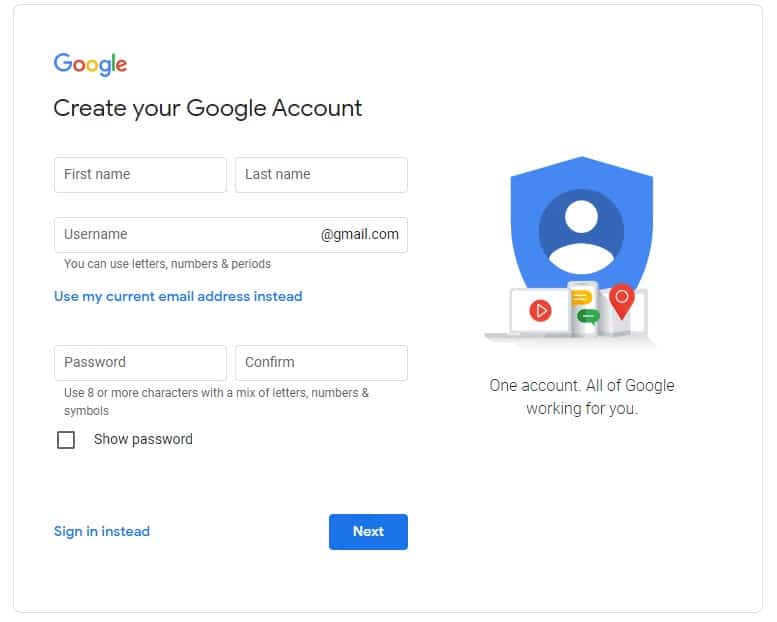
Step 2: Create Your Professional Email Address
If you don’t already own the domain name you plan to use with your email, you’ll need to purchase one from a domain registrar. If you don’t have a website host either, you may as well sign up with Bluehost to receive a free domain name with your hosting account.
With Bluehost, you’ll need to create an email account. While it might be tempting to click on the Email and Office button to set up your email account, that will take you to a page where you can purchase Google Workspace. Instead, click the “Advanced” button on the left navigation menu.
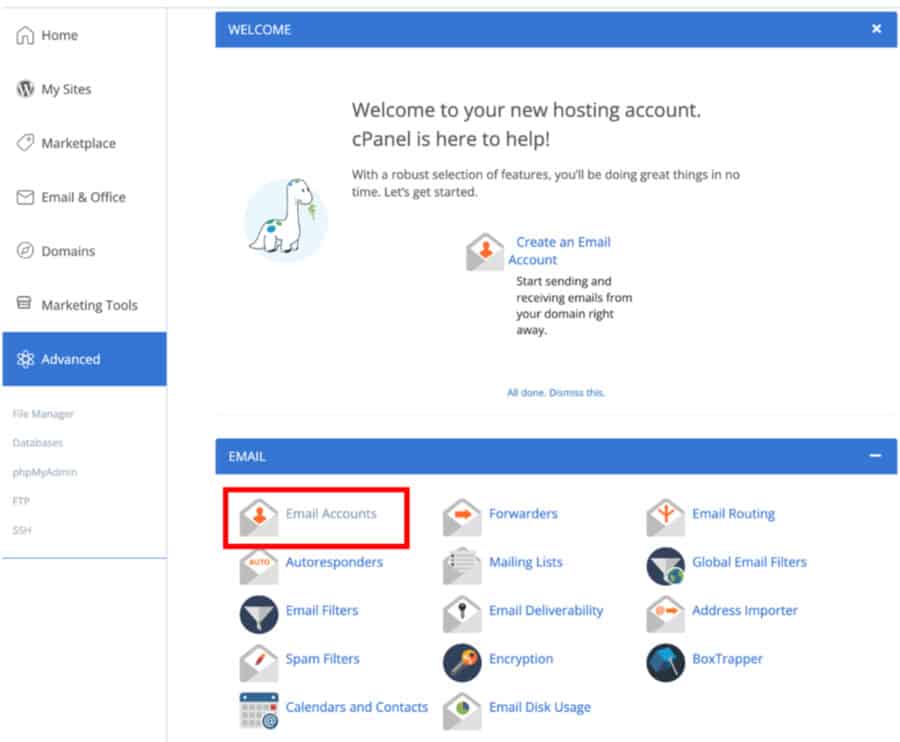
- Click on the “Email Accounts” icon in the email section. A new screen will open with a list of all your existing email accounts. At this point, there shouldn’t be anything there.
- Click “Create” to add your first email address
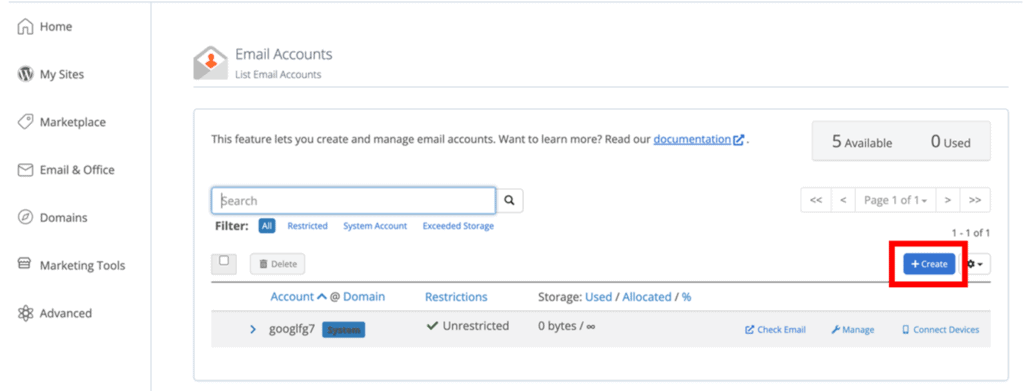
- Type in the username you want to use for your email. Remember, whatever username you choose is your email domain. You may want to use your name or something like Info or Office.
- Enter a secure password. You’ll need to remember this and use it when connecting to your Gmail account.
- Click the “Create” button at the bottom of the screen.
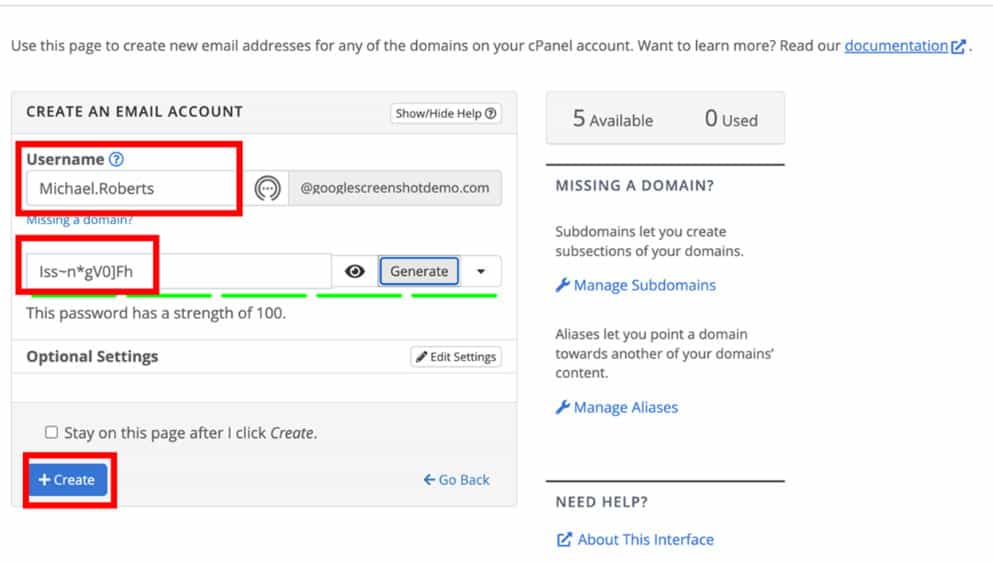
You can create multiple accounts and link them all to your Gmail account. Just repeat these instructions until you are done. When you are finished, you can see all your email addresses in a list.
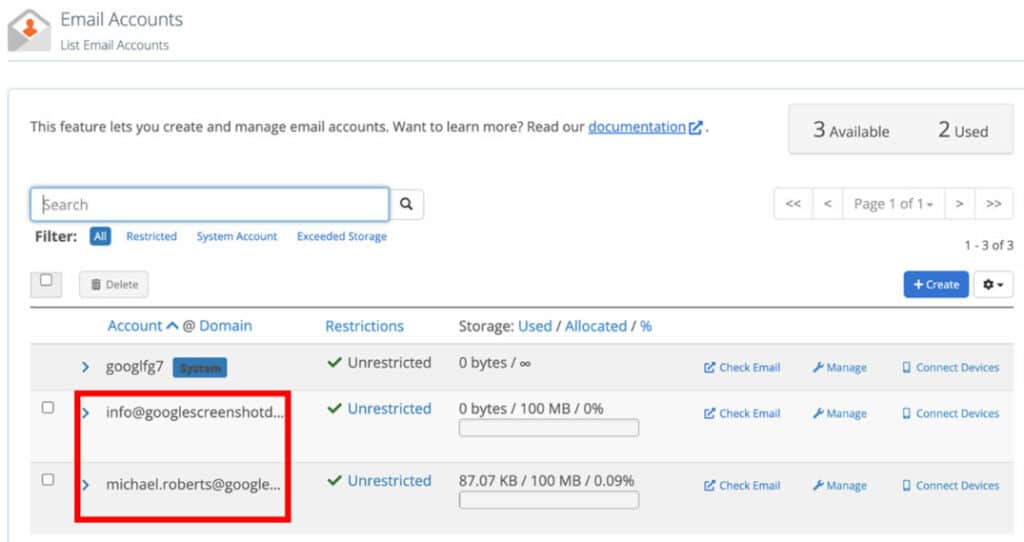
Step 3: Set up Gmail to receive email
There are two ways to receive an email in your Gmail account. You can either use POP3 or email forwarding. While both options work, POP3, where Gmail receives emails directly from the server, is a better solution. Each email can be labeled, making it easy to differentiate between work emails and personal emails. With forwarding, every email goes through the original account and is then automatically forwarded to your new address. Below are instructions on how to configure each method.
How to Set up Gmail to Receive Email Using POP3
POP3 sounds intimidating, but it’s pretty simple. It lets Gmail connect to your custom email address. Your free Gmail account will import email from your email host.
To get started, you’ll need to log in to your Bluehost account, or whichever provider is hosting your emails.
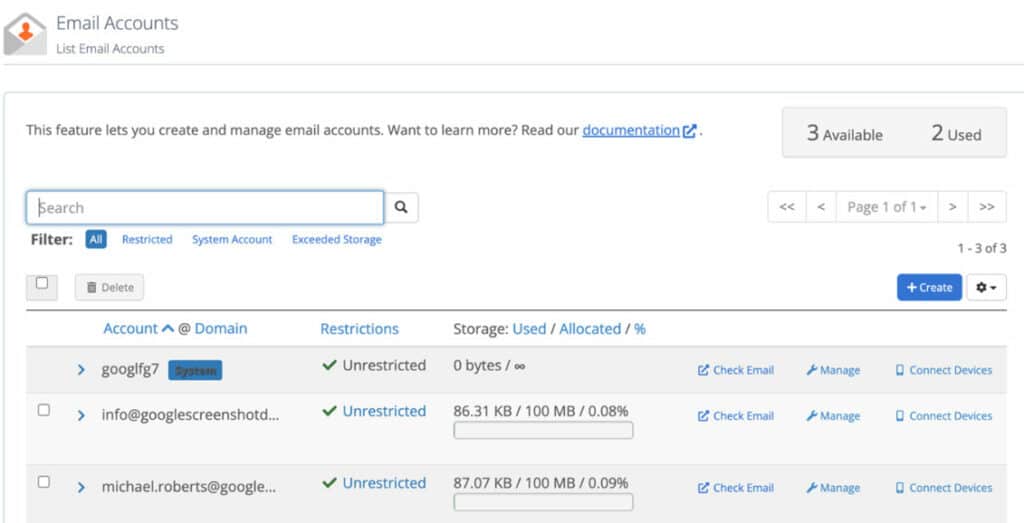
- Begin by clicking “Advanced” on the left navigation menu, and then choosing “Email Accounts.” This will open a list of your email accounts.
- Click on the “Connect Devices” on the row of the account you want to see in Gmail.
- Scroll down to a section called “Mail Client Manual Settings,” which includes your username, incoming server name, and POP3 Port. You will need these pieces of information for Gmail.
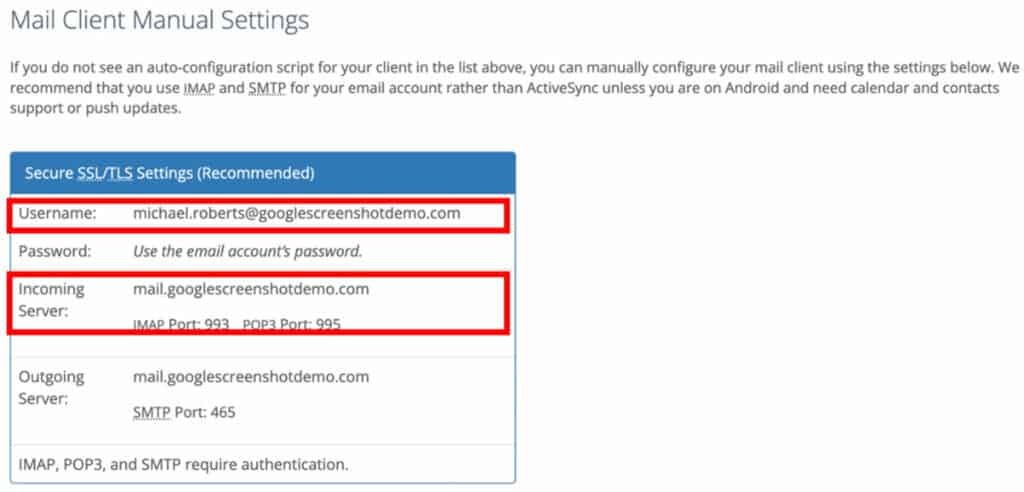
In another tab, open your Gmail account.
- Open Gmail settings by clicking on the gear icon in the top right corner and then clicking the “See all settings” button
- Click on the “Accounts and Import” tab in the center of the screen
- Find the option that says: “Check mail from other accounts.” Click on “Add a mail account.”
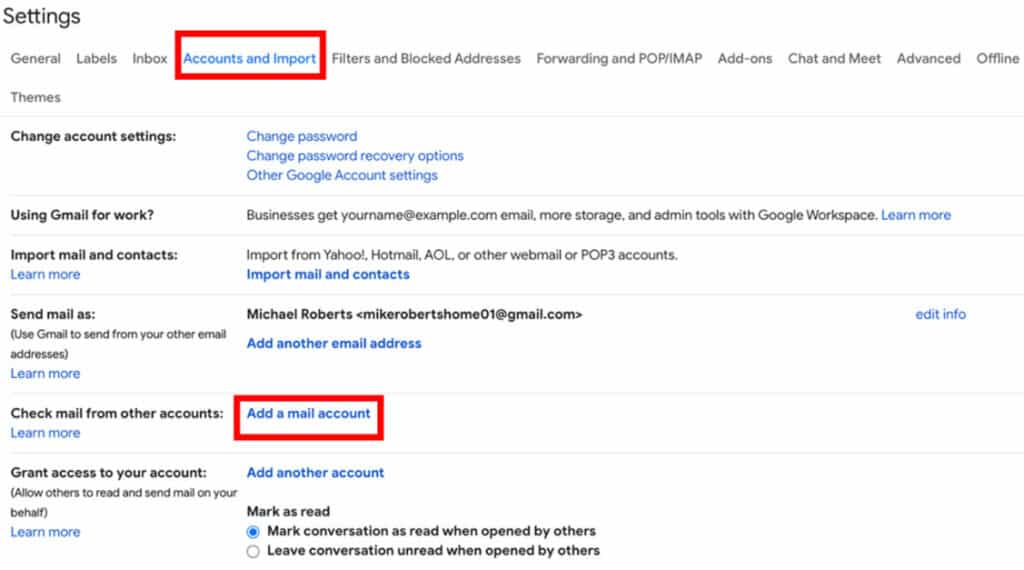
A new window will open, asking for your email address. Enter your new business email address into the window and click Next.
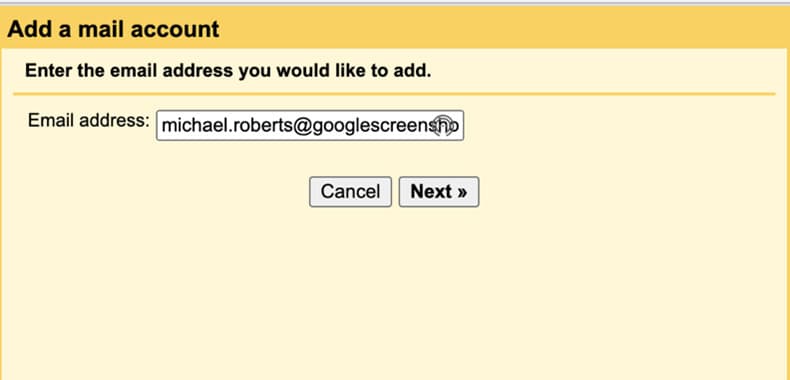
On the next window, click the radio button next to the option to Import emails from my other account (POP3) and click “Next.”
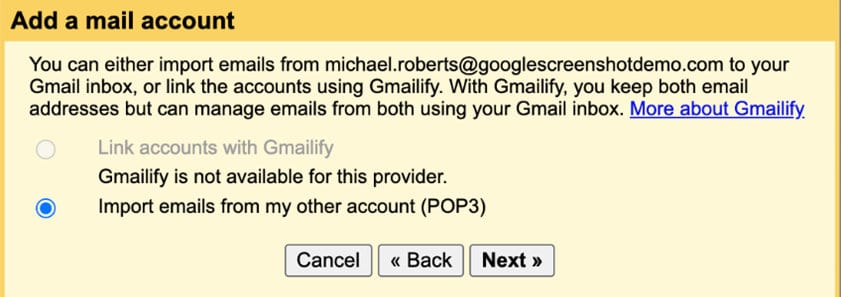
On the next window, you will need to enter the following information:
- Username – This can be your full email address or just the part before the @ symbol.
- Password – This is the password you created in Bluehost
- POP Server and Port Number – This is the incoming server name and POP Port number from Bluehost.
- Check the box next to Leave a copy
- Check the box next to Always use a secure connection
- Optional – check the box next to Label Incoming messages – This will help you track the source of an email, especially if you are connecting multiple email addresses to one Gmail account. I’ve labeled all emails as Work emails
- Click “Add Account.”
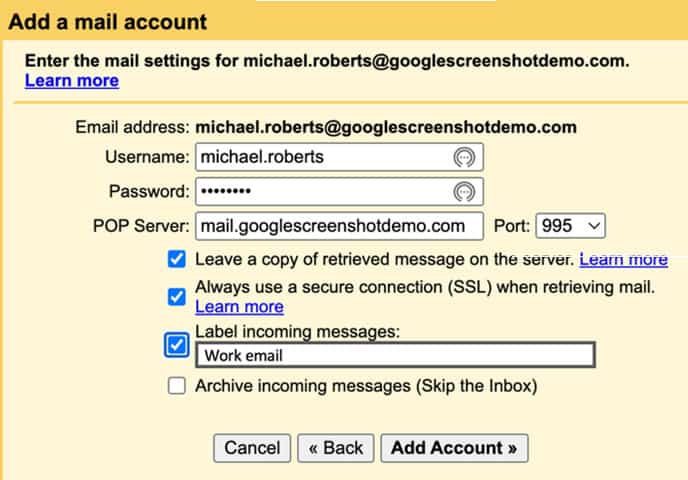
You will see a confirmation that the email account has been added.
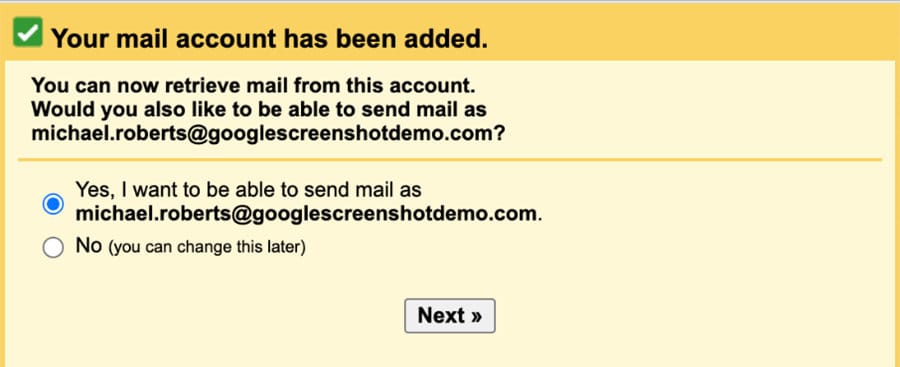
You can also see that your Gmail account is checking for email from your work account on the same settings screen we looked at a few minutes ago. To add additional accounts, click the “Add a mail account” button.
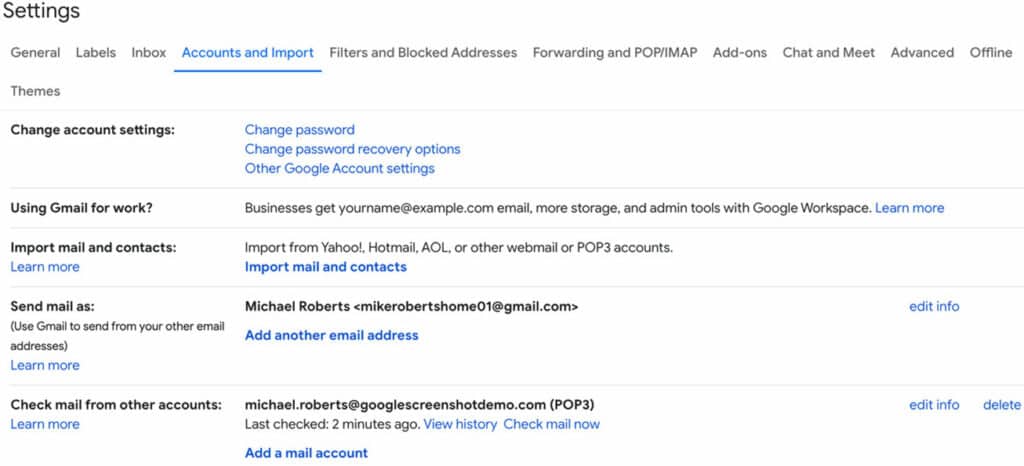
How to Set up Gmail to Receive Emails via Email Forwarding
As mentioned above, you can either forward emails to your Gmail account or set up POP3. There is no need to do both. All things being equal, I’d recommend setting up POP3.
Below are the forwarding instructions for several different web hosts.
If your host isn’t listed: Look at the HostGator instructions–chances are you have the same cPanel admin interface.
If that doesn’t work: Your provider might not include email forwarding. You can transfer it to Bluehost for a web hosting package that includes email forwarding. Just sign up with them here, and they will walk you through the seamless transfer process.
Using This Method With Bluehost
Click “Advanced” on the left navigation menu, and click on the “Forwarders” icon
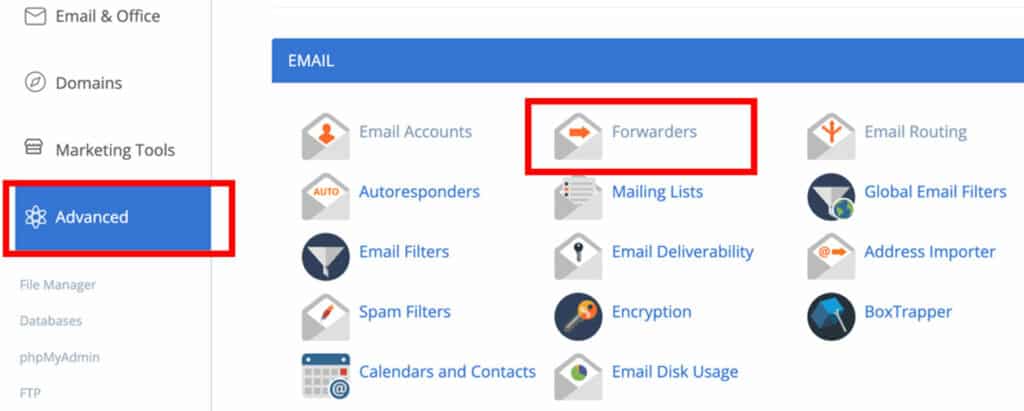
Click the “Add Forwarder” button
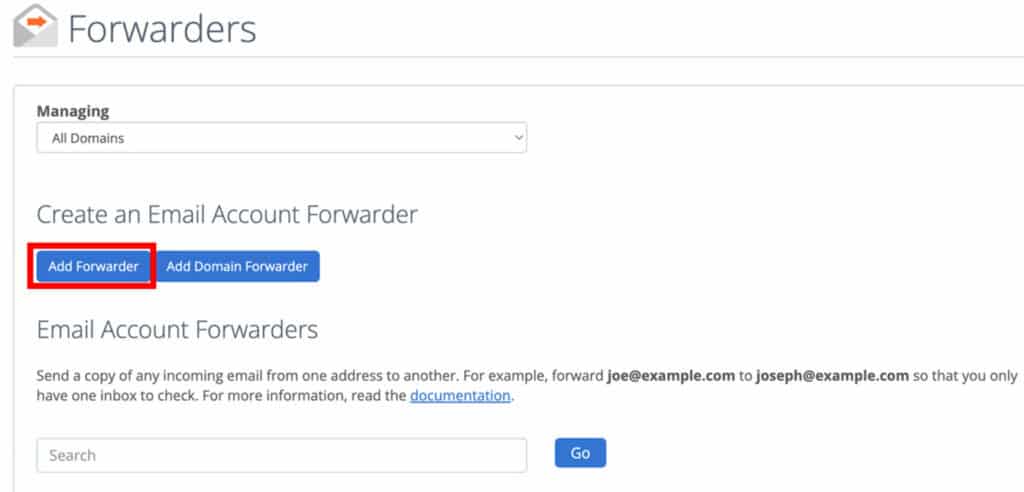
- Enter the name of your Bluehost email account that you would like to forward in the Address to Forward field.
- Enter the destination email address in the Forward to Email Address field (This should be the Gmail account you created)
- Click the “Add Forwarder” button
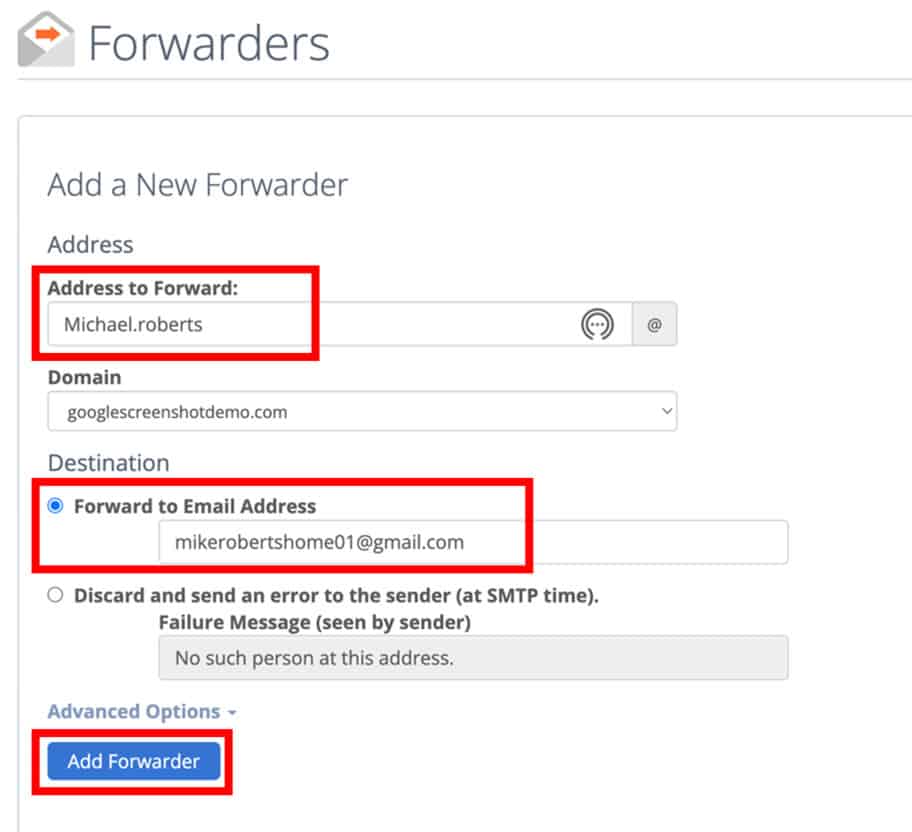
- Add as many emails as you would like. In this example, I added my Michael Roberts email address and my Info email address
- To test the system, send yourself an email and see if it appears in your Gmail account. If it did, you have successfully set up incoming emails for free in your Gmail account.
Using This Method With HostGator or Any cPanel Host
- Log in to cPanel
- In the Mail section, click Forwarders
- Under the Email Account Forwarders section, click Add Forwarder
- Type in the Address to Forward (you@yourdomain.org)
- Select “Forward to email address” (you.organization@gmail.com)
- Click Add Forwarder
Using this Method With GoDaddy
*Please note that as of December 31, 2020, GoDaddy no longer offers email forwarding credits. If you have an account that was created before this date, you can follow the instructions below. If not, you will need to purchase Office 365 Email Essentials for $23.88/year and then go into the GoDaddy settings for email forwarding.
- Log in to your account and click your name in the top-right.
- Select My Products from the drop-down
- Scroll down to the section called Additional Products
- Click the arrow to reveal the Email Forwarding section
- Click the Redeem button
- Select your domain name (Email Forwarding 100 Pack) and click Redeem Credit
- Wait for the page to refresh
- Scroll down to the Workspace Email section
- Click the arrow to reveal your remaining credits for Email Forwarding
- Click Manage All
- You’ll be redirected to the Workspace Control Center (you may be asked for your login details)
- Click Create Forward
- Under Forward this email address, type the address you want to forward (you@yourdomain.org)
- Under To these email addresses, add your Gmail address
- Click Create
Using This Method With DreamHost
- Log in to your DreamHost Control Panel and select the relevant package
- Click the Manage Email Addresses link from the Mail panel
- Click the Set up forwards link located in the right corner of the page
- Choose a name and domain for the forwarding address (you@yourdomain.org)
- Type your Gmail into the Forward Target(s) box
- Click Save
Step 4: Enable Gmail to Send From Your Custom Email Addresses using SMTP
The previous sections were all about receiving business emails to your Gmail account. In this section, we are going to set up the sending functions, using something called SMTP. Like POP3, SMTP looks intimidating, but if you follow these step-by-step instructions, you’ll be sending out business emails from your Gmail account in no time. We’re going to start back at Bluehost, on the same screen where we found the POP3 information.
- Begin by clicking on the “Custom Devices” tab in your email account.
- You’ll see a section called Secure SSL/TLS Settings. The bottom part of the section has outgoing server information and an SMTP port. You will need these pieces of information for Gmail.
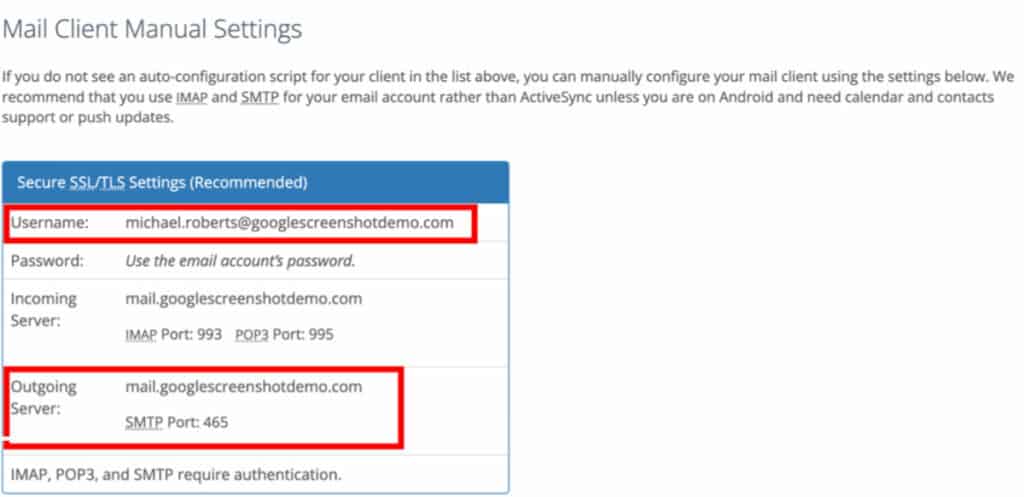
Once you have the information in front of you, it’s time to head back to Gmail.
- Open Gmail settings by clicking on the gear icon in the top right corner, and click the “See all settings” button
- Click on the “Account and Import” tab in the center of the screen
- Find the option that says: Send mail as. Click on “Add another email address.”
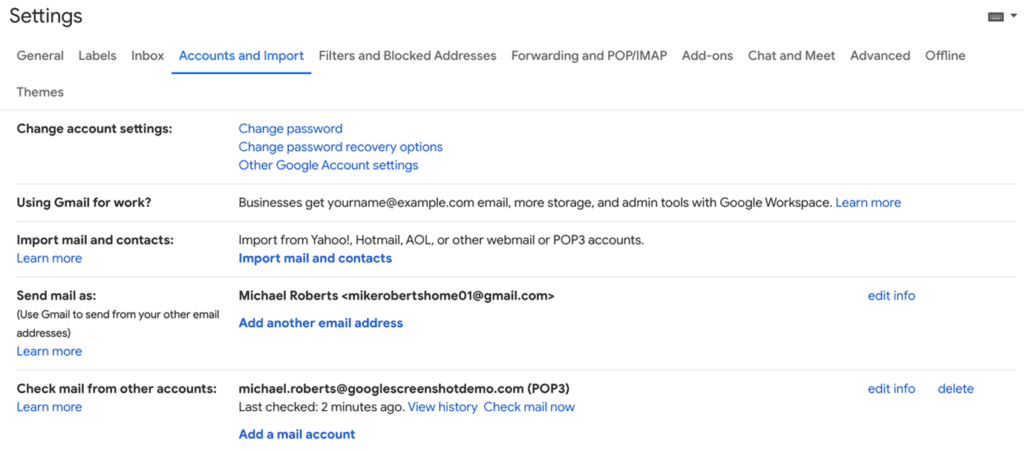
A new window will open. Enter the name you want an email recipient to see and your email address. Check the box next to Treat as an alias, and click “Next Step.”
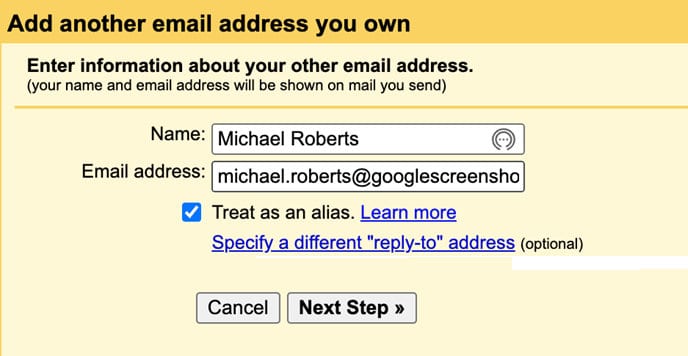
- Enter the outgoing server information and port that is included on the Bluehost site
- Enter your username and password from Bluehost
- Select the radio button next to Secured connection using SSL
- Click “Add Account.”
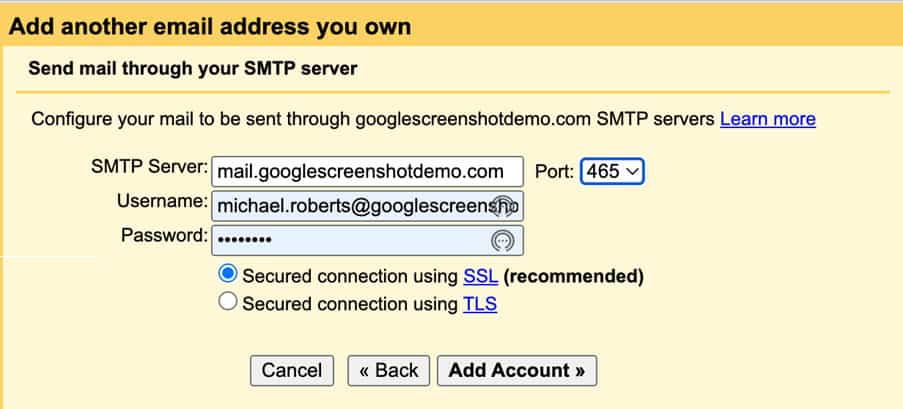
You will receive a verification notice. Follow the on-screen instructions and either click on the link in the email or enter a confirmation code in the window.
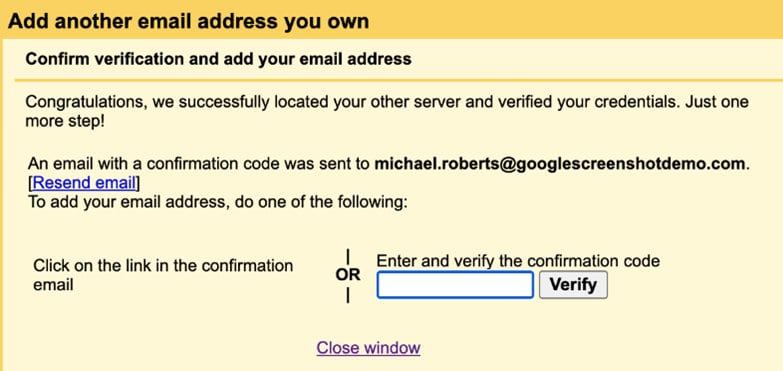
Step 5: Final Configuration
At this point, your email is set up so you can send and receive business emails from your regular Gmail account. Work messages will have labels to make it easy to track business emails.

When sending out messages, you should be able to select the account from which you are sending.

To test your setup, send an email to friends or your other email accounts to ensure that everything is set up correctly, and either reply or ask your friends to reply to make sure everything is working as expected.
And that’s it! You now have Gmail with your custom domain email for free!
If you have any issues, comment below and I’ll do my best to help you solve them.
How to Enable Gmail to Work with Your Custom Domain Name Through Google Workspace
Another option you have, if you’re willing to spend a few dollars a month, is to pay for an account with Google Workspace.
Google Workspace gives you a custom email address and access to several Google business productivity and communication tools, including:
- Google Drive – cloud storage
- Google Docs – cloud work processing
- Google Sheets – cloud spreadsheet tool
- Google Slides – cloud presentation tool
- Meet – a cloud-based video-conference platform
- Calendar – cloud-based calendar
Google Workspace makes it easier to share documents and collaborate with others in your organization. It can help your business look highly professional. The service costs between $7 and $22 per user, per month, but most small businesses can use the Business Starter package at $7.
There is also a Google Workspace Individual service, which includes some business tools for $9.99 a month. However, this service does not include a business email address.
Creating your Google Workspace account
Many web hosts, including Bluehost, allow you to create a Google Workspace account directly from their interface. This is the easiest way to set up a Google Workspace as all configurations are pre-set up.
If it isn’t an option, head over to Google Workspace and click the “Get Started” button. Follow the wizard and answer questions about your business name, number of employees, and the region where you are located. Although the process is pretty straightforward, we’ve created a detailed guide for setting up your email domain with Google Workspace.
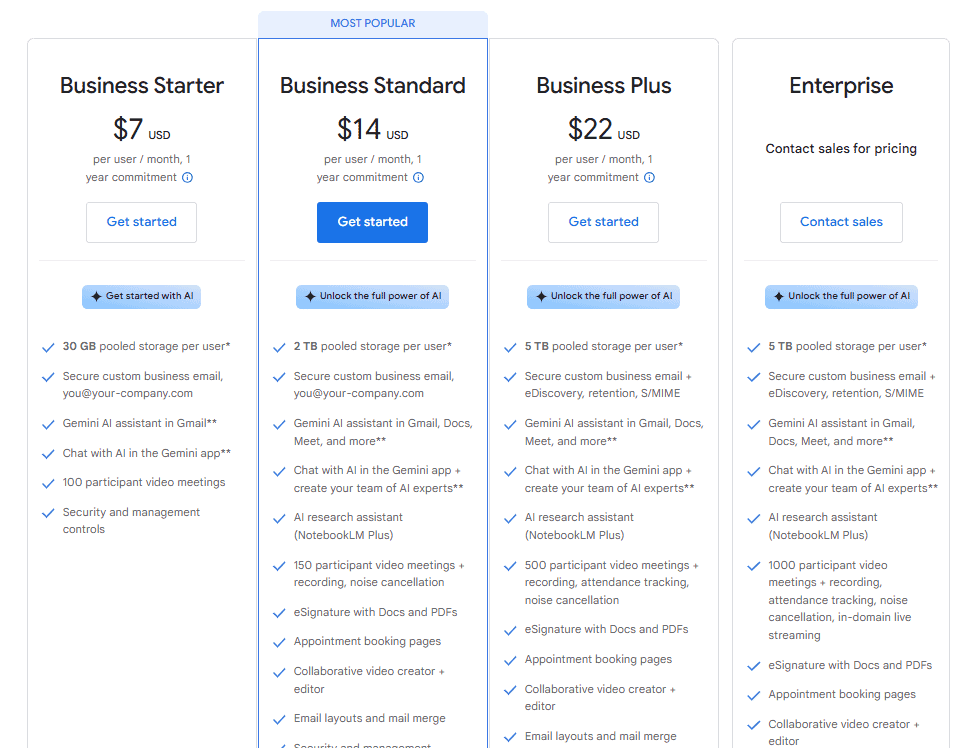
You’ll also be asked for your full name and current email address, and whether you have a business domain. If you have a domain you can enter it in, or you can search for one and buy it there directly.
You’ll be asked for a username and password, shown pricing options, and asked for payment information. You can try it for free for 14 days before being charged.
Get Started with Your Custom Gmail Email
In this post, we shared two methods for using the familiar Gmail interface with your work email. In the free method, you need to have an existing web hosting account first, and then you will have to do some configuration work to get everything running smoothly.
The second option is Google Workspace. This option is significantly easier but costs a little bit more.
If you have any questions or comments, leave a message in the comments, and we will do our best to answer.


Hey!
I’ve been using this (option 1) to use my online shop’s custom domain e-mail in my main Gmail inbox, and to use it for replying from that e-mail as well. It’s been working for years, however, I noticed this past year that a lot of my e-mails are getting lost in peoples’ spam folders more and more.
Is this something to do with using the Google e-mail server to send my custom domain e-mails? Is anyone else experiencing this? Would it be more beneficial if I just pay for a different e-mail host at this point?
Hi Dee,
I’ve been hearing more complaints than usual about this issue, so something is definitely going on here. You may already be doing this, but just in case, I suggest
updating the alias’s SPF record in Google Domains to include “_spf.google.com” as an authorized server.
I don’t like to speculate, but after closely following Google tools for many years, it would not surprise if this is a fist step towards them trying to effectively phase out email aliases so that they can get better control over spam and also incentivize users to pay for Workspace.
It looks like this will no longer work from May / June 2022. If you disable less secure apps now, then you can’t send emails from the custom domain set up as above using the gmail IOS app or clients like thunderbird.
This is so annoying! I’ve used your method for the past 12 years without an issue. Like someone else has conmmented, I also use this for our own personal family email addresses so a paid for option just isn’t viable for that kind of use. For what it’s worth there is a free service for email from zoho using your own domain which includes the use of DKIM and SPF records too. The downside is that there’s a limit of 5 email addresses in total, and no IMAP or SMPT is available on free accounts – so you have to use webmail or their own ZOHO mail app on phones.
This is indeed the case. I am investigating possible solutions and will update when I have something concrete. Stay Tuned!
Great to know you’re looking into it. All efforts are massively appreciated, Yaron. 🙂
Hi Jason, a really well written article that has got me 90% of the way. The last 10% is that mails are failing Microsoft’s spam filters as there is no DKIM, A recent reply on this very subject refers you to setting up DKIM for Google Workspace, which is a paid service but this blog is for a free service. I cannot see how to enable DKIM for free GMAIL, I can of course set up the DNS records for this but the server needs the private key. Any ideas? I think in light of recent activity Google do not want you to send emails from a custom domain unless you use workspace….
Hi Nathan,
Thanks for writing. I agree with you but will have to check back and get back to you!
Hey! Seems there is no way. You will have to pay…
I need help understanding impact of Google terminating legacy Google Apps / G-suite account. I have chatted with Google support but they only say that Google is still considering how to handle legacy personal accounts (not business, not non-profit accounts).
Background:
I adopted Google Apps as soon as it was offered (about 2006) and have been using it exclusively to manage my family’s email accounts that use our personal domain name (lorax.us).
When Google terminated the free level of Google Apps in 2012 they ‘grandfathered’ previous users and everything continued as before.
Just recently Google said that they will force legacy users to upgrade to paid G-Suite plan (minimum of $6 / email address / month) or terminate the account.
I do not need any other Google service that is part of the paid G Suite plans.
So paying $54/Month for my family’s 9 email accounts is far too expensive for that limited service (just have a custom domain name).
My custom domain name is NOT hosted by Google.
I have my domain host settings forward our emails to Gmail.
This has worked fine for 16 years.
I am not clear how Google’s new rules will effect my emails if I don’t upgraded to a paid plan.
Doesn’t Gmail natively allow users to receive/send email from other email services?
So would my emails continue to be routed to Gmail (such as to my admin@lorax.us address)?
But I don’t have an underlying true Gmail account ( * @gmail.com).
I only have the *@lorax.us email address this currently managed by Gmail/G-Suite.
I’d be grateful if anyone has any better insight to continued use of custom domain name emails in Gmail if G Suites terminates my account.
I have the same issue. I am thinking about just creating my own email server but my YouTube TV, YouTube and Google Calendar are all unfortunately tied to the Gsuite account.
Hi there, thanks for the information.
Google confirmed that they are discontinuing free own-domain e-mail service as off July 2022.
I’ve been using their service for more than 10 years, but now we’ll have to find alternatives, or pay for every account we might have.
You can still use it for free with @gmail.com accounts…
This is correct. You have until May 1, 2022, to switch and will be required to pay by July 1, 2022. If you do not wish to continue you can export your data using the Google Data Export tool.
Should we then go back and disable “Less secure apps”?
yes!
Google announced yesterday that the free option is closing in June (accounts not transitioned to pay accounts will be dead 1 July 2022) The least expensive account remaining will be $6/user/month payable annually.
https://support.google.com/a/answer/60217#faq
This is correct. If you have a legacy account you will be able to switch to Google Workspace until May 1 2002 and stay free until July 1, 2022.
Hey Jason,
thanks for your article. It really helped us. We can now successfully send emails via our custom domain. That’s nice. Thanks.
However, we still experience issues, that our mails land in spam. We did already add the SPF domain record, but that did not completely solve it. Debugging problems with a tool like mailgenius.com or mail-tester.com tells us, that there are currently still 2 problems:
1. Our emails lack a DKIM signature
2. From and EnvelopeFrom 2nd level mail domains are different
I expect these problems to cause the issues with the spam folder.
If you or anyone reading this has a solution to that problem, I’d be super thankful to hear about it.
Kind regards,
Pascal
Hey Pascal,
You will need to set up the DKIM. Google “DKIM setup to prevent email spoofing” You will be taken to a workspace support page where there is a step-by-step guide on how to set this up. Good Luck! Hope that helps.
Amazing post, many thanks for this amazing content.
This was SO helpful, thank you!! I really appreciate it. I only hit one snag when adding the alias for outgoing mail. If anyone is having trouble with that part, be sure you have 2-factor authentication turned on for your Google account, and then follow the instructions at this link to get your single-use stmp.gmail.com login: https://support.google.com/domains/answer/9437157?authuser=1
Brilliant. Worked a treat first try! Gracie!
Is there a way to send google calendar invitations using you custom domain address?
Hi,
Yes you can. Just create an invite in your Google calendar and it will automatically send using your custom address.
Bluehost does not offer free email forwarding with only a domain purchase. I just followed all your steps and purchased the domain from Bluehost to then find out you actually need a web hosting account to have emails forwarded. What a pain. I hope you will consider updating your article for accuracy. I would have gone with GoDaddy if I hadn’t read your article. GoDaddy is a few dollars cheaper if you consider getting a domain and email service for 5 years
Hi Bobby,
Sorry for the misunderstanding. You are correct in that Bluehost is a web host that offers email hosting and forwarding as part of their package. However, the reason we recommend this for people that want to use Gmail to manage their domain emails but do not want to sign up for Google Workspace is because it’s honestly the best option. If you were to use use GoDaddy as you suggested, you’d have 2 options: using one of GoDaddy’s 2 email packages (Email Essentials for $1.99/month or Email Plus for $3.99/month) or using Office 365 for $8.99/month. None of those options will allow you to use Gmail. The GoDaddy email tools are very simplistic, have terrible reviews, and lack most of the features that are available for free from Gmail. The Office 365 option is more expensive than Workspace and not nearly as user friendly. So using Bluehost with email forwarding is a much better option on all accounts.
Hi, following along here and I am a bit confused. It appears to me that Bluehost only offers email hosting through Office 365 or Google Workplace (each requiring a subscription). I did dig deeper into the settings and was able to follow your beautifully explicit steps in forwarding email without either of these, using a @gmail.com account but ran into an issue at the end of step 3/beginning of step 4 when needing to confirm/verify the change. Without a mailbox or original hosting for the target email address to begin with, it seems as though there is no way to receive the conformation email with the verification code to complete the change. Am I missing something?
Hi Corinne,
The email should be coming to the original address that you signed up with. The alias is just for when sending out mail. The same email you used in step 3, should be the inbox that the verification link arrives at. Let me know how it goes!
Hi Yaron,
Yes, I follow you there but my question is about that original email. I have a domain and web hosting from Bluehost but I do not see the option for email hosting without getting a subscription (to either Office 365 or Google Workplace). I’m wondering if that’s right, since it seems from the post that Bluehost offers at least a basic email hosting for free with web hosting. I’m just not seeing that and without hosting for the original email it doesn’t seem there is anywhere for that confirmation email to land. I’m wondering if I am missing something or if I really do need to get an additional subscription to support email hosting. In which case there doesn’t seem to be much sense in setting up an alternative account.
Hi again,
I found it! Perhaps this is the same issue Bobby was having as well, but these steps helped me find the email login and hosting section under my web account. Not intuitive, Bluehost, and a lil sneaky and frustrating, but thanks to this post and the link below I now have working email!
https://www.bluehost.com/help/article/email-account-management#create
Awesome! Glad it worked out.